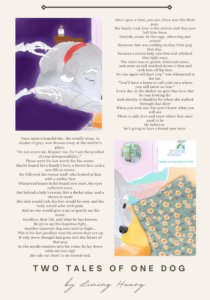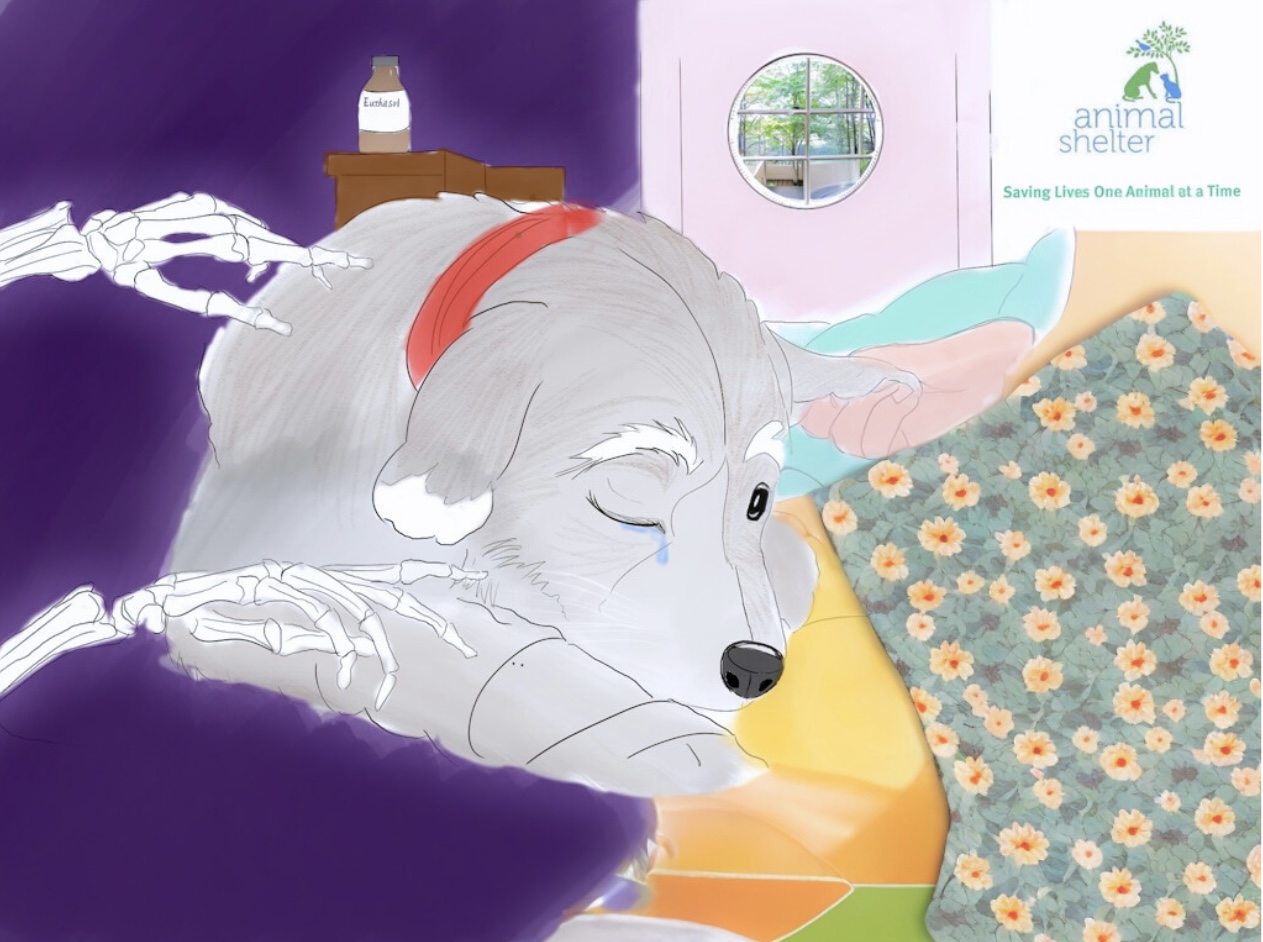
See the Flip Side: Written Statement of “Two Tales of One Dog”
In crafting this project, I created two poems that serve as contrasting perspectives on the plight of stray animals. The two poems combine the perspectives of people who share common traits as they are all animal lovers, protectors, and activists but seem to be the antithesis of each other. In the two poems, the same stray dog could have two entirely different outcomes: he might, with the help of rescuers, enter a shelter and eventually find a loving family to adopt him, breaking free from the life of wandering the streets and enjoying a life filled with love and care. However, he could also end up on the other end of the spectrum—despite luckily residing in the shelter, he cannot secure time-limited happiness. If he is not adopted within seven days, he will be euthanized. Meanwhile, my accompanying painting echoes these two different situations; the drawing also comes from existing work—an advertising photo of a stray animal shelter. In the original picture, a stray dog is surrounded by caring rescue staff: they wrapped up his wounds and caressed his ear and paws. I recreated the image by dividing it into two halves. The right side portrays a happy stray dog being affectionately touched by rescue personnel, with his wounds bandaged. The left side, however, depicts a small dog facing the inevitable, tears streaming down his face, unable to resist his fate.
My identity is closely knitted into this project because I felt my identity was misrepresented when I came across the photo of the animal shelter. As a dog owner, animal lover, and someone who has interacted with several large stray dog shelters in China, my first reaction was, “I don’t think that’s the full picture.” My family and I have been supporting animal protection organizations and stray animal shelters for years, and in the past three years, I have visited several stray dog shelters in my hometown. The experiences from these visits have been quite impactful. Among the five shelters I visited, only one had the principle of “not giving up on any dog.” The manager of that shelter was willing to bear all the losses, adopting all the stray dogs, personally funding their treatment, and living with them alongside volunteers who care for the dogs every day. However, the remaining four shelters, without exception, set deadlines for the stay of stray dogs in the shelter: some for a month, while others for two weeks. Regardless of the duration, once this time limit is exceeded, the stray dogs are euthanized, while these truths are rarely reported.
Through this project, I aim to shed light on the often-overlooked realities from a more comprehensive perspective. Similar to the original image my painting is based on, which features a rescue dog in a shelter filled with love, much of the animal shelter and mainstream media promotion tends to highlight the happy lives of rescued stray dogs. It’s worth acknowledging that a significant number of animals successfully find new homes, starting fresh lives. However, very little media coverage, especially in China, is devoted to the fate of the left-behind animals and the wide usage of euthanasia for stray animals. Some darker aspects have not even surfaced and appeared in the public eye: in some cases, unscrupulous animal shelters might even misuse euthanasia to cut costs, a profit-driven approach that deserves serious condemnation. While criticizing the inappropriate adoption of euthanasia, my project isn’t outright rejecting the feasibility of euthanizing stray animals. Under certain reasonable conditions, euthanasia is not an unwise choice: in situations where an animal is seriously ill, injured, or poses a danger, it may be the only humane course of action. However, I hope to inspire reflection on the primary cause that imposes euthanasia as the last resort to our hands. The discussed reasons, like illness, injury, and threats to human safety, are only a small part of the reasons for euthanizing animals. Most animals euthanized are due to the number of lost or unwanted animals surrendered to shelters exceeding the number of adopters. According to the American Society for the Prevention of Cruelty to Animals, roughly 6.5 million animals enter shelters each year, but only 3.2 million are adopted. Undoubtedly, the main culprit for overcrowding primarily lies with irresponsible pet owners who make decisions to get pets without serious consideration, abandon animals without fulfilling their duties, and casually discard lives. But another contributing factor often goes overlooked—the responsibility of animal shelters. While they do a commendable job rescuing stray animals, their promotion is often one-sided and overly positive, showcasing only heartwarming rescue scenes. This can inadvertently justify the actions of those who abandon animals, thinking that shelters will take good care of abandoned animals and that perhaps animals can even live better than they are at home. To prevent this problematic justification, it’s crucial to unfold the fact that shelters are not omnipotent saviors or clean-up crews. Animal shelters contribute to rescuing, but that cannot be a proper reason for unscrupulous sabotaging.
In my project, different materials supplement each other, just like how critique and remixing become complementary to each other. Remixing becomes a methodological cornerstone, fostering originality by combining disparate perspectives and voices to serve my original goal—piecing together a more comprehensive image of sheltered animals’ lives. As I explored materials with a critical lens, I noticed a gap where no single source brought together the praise for animal shelters, criticism of euthanasia, and condemnation of irresponsible pet ownership. My remixing approach serves as a critique by intervening in the discourse that often leans towards a singular perspective. In my view, these three aspects are interconnected. I ended up selecting a total of seven sources, and the quotes I used are straight from the unfiltered expressions of everyday individuals. In the varied voices of ordinary animal lovers and protectors, I find the value of authenticity originated from spontaneous reflection in everyday life. By quoting and remixing their opinions and thoughts, just like what we’ve read in Judith Butler’s “What is Critique,” my aim is not to negatively criticize any singular perspective (1), but to remix to fill in the blind zone, creating a more holistic and inclusive view. Out of all the outside materials, I utilized three sources praising animal shelters for remixing Poem I; the remaining four sources, three condemned euthanasia, and one criticized the irresponsible abandonment of animals, were remixed for Poem II. The juxtaposition of these two poems is about complementing, critiquing, and presenting the facts to each other. By combining the three perspectives, I criticize the condemned euthanasia itself as merely an outcome. The real focus should not be on the outcome but on the cause—especially a reevaluation of positive propaganda of animal shelters. Through this intervening discourse, we can analyze that solely highlighting the positive side may not always yield the expected positive results. Born from remixing, my original message is strengthened: giving the excessive spotlight on the upside while masking the downside may not produce a good effect but worsen the existing negative phenomenon. The concept of remixing is akin to unfolding both sides of a coin, not fixating on a single flip side but rather contrasting to contemplate a fuller picture, which is what an extended examination, a critical lens, can offer.

Comments are closed, but trackbacks and pingbacks are open.